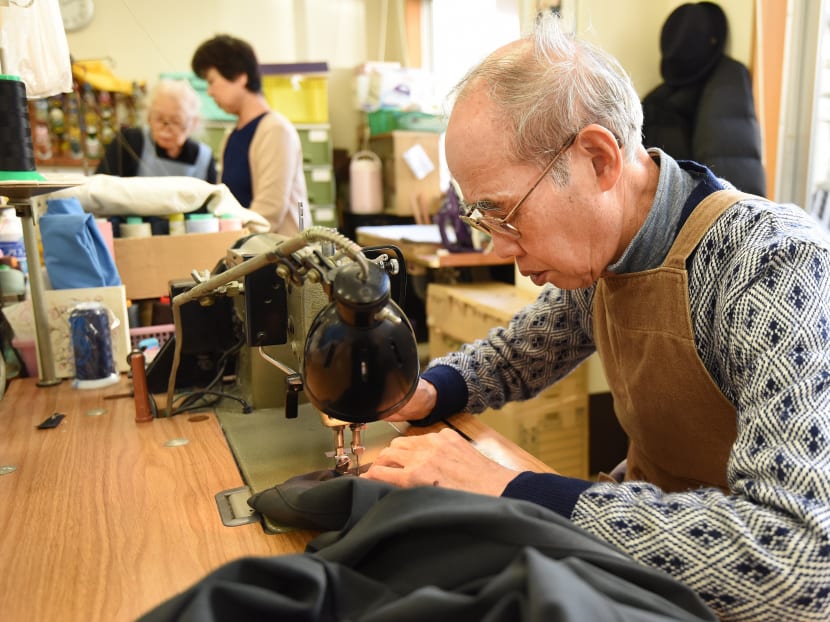Japan’s silver-haired seniors still punching the time clock
TOKYO — Many people his age would be happy to slip on a cardigan and put their feet up, but not Mr Teruo Sugiura.

In this picture taken on December 18, 2015, workers repair clothes at a seniors' work centre in Tokyo. Japan's silver-haired workforce is everywhere these days -- from wrinkled men waving glow sticks at construction sites to checkout counter clerks or caregivers for the very old. Photo: AFP
TOKYO — Many people his age would be happy to slip on a cardigan and put their feet up, but not Mr Teruo Sugiura.
The 86-year-old makes his way to a seniors’ work centre in Tokyo several days a week where he repairs traditional Japanese sliding doors.
It doesn’t pay much, but that hasn’t stopped Sugiura from turning up for the last 20 years — one of millions of elderly Japanese still collecting wages into retirement age.
“I’m working to keep my body in good shape,” said Mr Sugiura, a former sweets salesman at a high-end department store.
“I think it’s wrong not to be doing anything. There’s no point staying at home twiddling my thumbs.”
Japan’s silver-haired workforce is everywhere these days — from wrinkled men waving glow sticks at construction sites to checkout counter clerks or caregivers for the very old.
And this geriatric working class shows no sign of shrinking — more than 20 per cent of Japanese older than 65 still work.
That is the highest proportion among developed economies and a figure likely to soar as the pool of younger workers falls and the fast-ageing population squeezes a strained social welfare system.
People over 65 are expected to account for nearly 40 per cent of the greying population by 2060 as Japan wrestles with a low birth rate.
Meanwhile, the country’s labour force — the number of employed and unemployed people aged 15 to 64 — is at risk of losing more than 27 million workers in the same time frame, a drop of about 42 per cent from current levels, according to a government advisory panel.
Demand for workers is high and Japan’s unemployment rate for January, published on Tuesday (March 1), was an enviable 3.2 per cent, a two-decade low and well below the United States or many European nations.
MARKET PRESSURE
In response to demographic shifts, the government is gradually raising the official retirement age and starting ages for state pension payments to 65. The official retirement age will be raised in steps from 61 to 65 by 2025. It will be raised to 62 next month.
“This is enough incentive for (seniors) to push back their retirement and keep working,” investment bank Goldman Sachs said in a recent report on Japan’s labour market.
And Tokyo is putting the pressure on firms to keep workers on longer, or by hiring older employees.
Some firms have responded, including automaker Honda which has said it would raise its working age by five years to 65 starting in April, a move that could affect tens of thousands of workers.
Meanwhile, in northern Japan, nationwide convenience store chain Circle K Sunkus has trained a handful of elderly people in a nod to the ageing labour pool.
Electronics giant Ricoh has called on retired technicians to get its computers ready to be installed at companies, schools and government departments.
“There is very strong market pressure for employers to keep older people,” Mr Atsushi Seike, a professor of labour economics and president of Tokyo’s Keio University, told AFP.
“The drastic decline of the workforce will have a significant impact on the behaviour of employers. Many are willing to boost the number of older workers, even at major companies, and I think this trend will continue — or even accelerate — in the future.”
More than half a million older Japanese find work through the government-subsidised National Silver Human Resources Center Association, including door repairman Sugiura and 63-year-old Junko Kondo.
Ms Kondo’s government pension isn’t enough to let her do everything she wants.
“I’m saving the money I make here,” Ms Kondo says, as she assembles packages for wrapping up high-quality salt sold at luxury stores.
“I’ll use it to buy presents for my grandchildren, or a sweater, or maybe just lunch for myself.”
The reasons for Japan’s elderly staying in the workforce vary, but keeping mentally and physically fit is key for many people.
It also puts some extra money in seniors’ pockets, although the wages paid by the Silver Centres are low — they pay an average of ¥37,000 (S$455) a month.
Some seniors only get paid per task they complete while others volunteer their time without getting paid.
But for people like Ms Taeko Mishima, the extra money could be a lifesaver.
The 74-year-old worries she and her husband’s pensions are not enough to cover the cost of nursing homes with medical care, which could add up to as much ¥300,000 a month, said Ms Mishima, who formerly worked at a travel agency.
“My pension isn’t high enough to pay for that.” AFP






